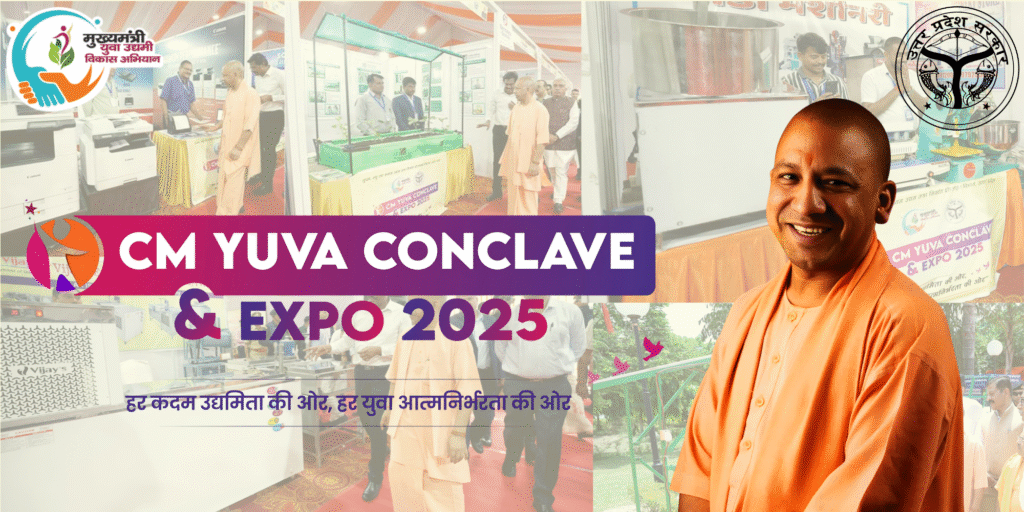
Imagine a young baker in Kanpur, a traditional wooden toy maker in Lucknow, or a biotechnologist launching eco-cleaning products—all flourishing thanks to a scheme that eased loans and doubts alike. On July 30, 2025, Chief Minister Yogi Adityanath inaugurated the CM YUVA Conclave and Expo–2025 in Lucknow, marking a transformational moment in Uttar Pradesh’s journey from youth unemployment to youth-led enterprise.
This bold initiative stems from a vision that sees youth not as passive beneficiaries of government support, but as active drivers of economic growth. Under Yogi Adityanath’s leadership, the state has reimagined how governance can empower individuals. His long-standing focus on building local capacities and entrepreneurial ecosystems finds clear expression in this scheme.
A Bold Vision Meets Real Impact
Launched under the Mukhyamantri Yuva Udyami Vikas Abhiyan, the CM YUVA Yojana has emerged not merely as a credit-linked programme, but as a full-spectrum entrepreneurship ecosystem. Over 68,000 young aspirants have received interest-free, collateral-free loans totaling ₹2,751 crore.
The scheme provides:
- Loans up to ₹5 lakh (extendable to ₹10 lakh upon performance)
- 10% margin-money subsidy from the state government
- Loan guarantees and interest support are covered by the government
- ₹5 lakh insurance cover for entrepreneurs
- Zero licensing requirement for the first 1,000 days

These elements remove traditional roadblocks such as lack of capital, credit history, or bureaucratic friction, creating a more level playing field for aspiring entrepreneurs.
Voices from the Ground: Youth Making It Happen
Prabhnoor Kaur, a trained baker from Kanpur, secured ₹4.25 lakh to launch a luxury bakery studio employing ten locals. Vijay Pandey, a traditional wooden toy artisan, expanded to supply 16 districts after his loan was approved within 15–20 days. Shashank Chaurasia, an ex-pharmacist turned wedding photographer; Tuba Siddiqui, who launched eco-friendly cleaning brands; and Amardeep Singh, who opened a physiotherapy centre—all credit the scheme for transforming their career paths.
These stories show how entrepreneurship is no longer an abstract aspiration but an attainable livelihood when backed by smart policy and efficient delivery.
Conclave Highlights: Platforms, Partnerships, Possibilities
The CM YUVA Conclave and Expo 2025, held at Indira Gandhi Pratishthan in Lucknow, stood out not just for its scale but for its substance. Designed as a comprehensive business ecosystem, the event brought together the entire entrepreneurship value chain, offering young people an unprecedented opportunity to explore, engage, and evolve.
Key highlights from the two-day conclave included:
- 500+ machinery suppliers offering essential tools for enterprise creation
- 100+ franchise brands with proven business models
- 25+ banks and financial institutions offering on-ground funding access
- 20+ educational institutes providing pathways for skilling and certification
- Over 10,000 youth participants interacting directly with business leaders, investors, and mentors

The event was not just symbolic—it offered hands-on learning, real-time networking, and institutional support. The launch of the UP Mart portal, a digital marketplace for machinery, services, and support, added a permanent layer of infrastructure to the initiative.
This ecosystem-centric approach has been actively guided by senior officials, including Alok Kumar, Additional Chief Secretary, MSME & Export Promotion, Infrastructure & Industrial Development, and NRI Department, and Chairman of YEIDA. His role in shaping the policy framework and streamlining interdepartmental coordination has been instrumental in ensuring the program’s scale and success.
Strategic Synergies: ODOP & MSME Ecosystems
The One District One Product (ODOP) initiative, launched in 2018, continues to serve as a complementary pillar to the CM YUVA Yojana. ODOP has helped boost UP’s exports from ₹86,000 crore to over ₹2 lakh crore, while reviving traditional industries. Many young entrepreneurs under CM YUVA are aligning their ventures with ODOP clusters, creating localized value chains.
Simultaneously, the MSME sector—home to 96 lakh units and employing over 1.65 crore people—offers critical mentoring and supply chain support to new entrepreneurs, further anchoring their success within a robust industrial ecosystem.
Education, Inclusion & Expansion
Recognizing the information gap between higher education and real-world opportunity, the government has initiated MoUs with universities to integrate entrepreneurship into the academic experience. This ensures that youth are not left guessing their next steps after graduation but are equipped with tangible avenues to pursue.
Women entrepreneurs are also playing a prominent role in this movement. Entrepreneurs like Prabhnoor Kaur and Tuba Siddiqui are not just building businesses, but also generating jobs in their communities. The scheme includes targeted support and simplified processes for women-led ventures.
With a goal to support 10 lakh youth over the next decade, the government plans to replicate the conclave model across all 18 divisional headquarters in the state, expanding its reach and relevance.
Why This Matters: A Scalable, Sustainable Model
Today, Uttar Pradesh is emerging as a blueprint for states working to address youth unemployment through sustainable, inclusive approaches. By combining financial access, institutional mentoring, digital infrastructure, and community-driven execution, the CM YUVA Yojana has evolved into a full-fledged entrepreneurship ecosystem, not just a standalone government scheme.
As UP-based ventures prepare to showcase their innovations at the upcoming International Trade Show in Noida (September 25–29, 2025), the state’s contribution to Aatmanirbhar Bharat is becoming increasingly visible and tangible.
While several states across India are making commendable strides in youth empowerment and entrepreneurship promotion, what makes Uttar Pradesh’s model noteworthy is its scale, speed of implementation, and emphasis on end-to-end support—from funding and skilling to market access. It offers a replicable framework that can inspire others, especially when it comes to integrating government policy with real-world entrepreneurial infrastructure.
The success of this initiative is no accident. It reflects a leadership philosophy that blends vision with execution, scale with empathy, and policy with grassroots reality. And that’s why, for thousands of young people in UP today, the question is no longer “Where can I get a job?”—but rather, “How many can I create?”

